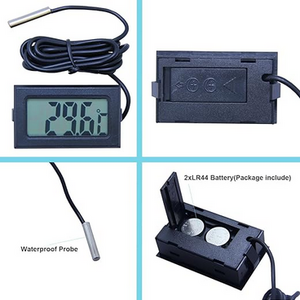How Do I Know When the Hot Water Has Run Out?
This is an apparently simple question: how do I know when the hot water has run out? The hot water thermostat is measuring a temperature about 300l below the top of the tank, so it reports colder than what comes out of the top. Of course, I could run the hot tap and see how hot it gets, but that is a rather crude measure and wastes water. Below is some background.
Our Grant Aerona 290 15.5kW heat pump was installed last week. We have 2x200l cylinders plumbed in series. Cold water flows into the bottom of the first tank, hotter water comes out of the top and goes into the bottom of the second tank. Hot water for the house comes out of the top of the second tank. Both tanks are heated by a single plate heat exchanger, which works well. We also have a hot water loop with circulation pump that comes on at meal times for washing up.
Almost all of the time, only two of us live in the house, so 400l should probably last us 2-3 days. We are on the Intelligent Octopus Go tariff of about 7p per kWh overnight and 29p during the day. In order to minimise the cost and avoid cycling the heat pump, I have set the water to run for an hour each night, plus a weekly Legionella cycle a couple of hours later.
The hot water thermostat is located at the bottom of the first tank. I assume the water stratifies, with the hottest water at the top and the coldest water at the bottom, although the plate heat exchange and hot water loop must interfere with this to some extent.
The reported temperature gradually declines from about 47C after heating to about 35C by the following evening. At tea time, it briefly dropped to 30C, but recovered to 35C without the heating being turned on. I was concerned that the water might be too cold, but my wife and I both had showers and the water was nice and hot. Of course, it came out of the top of the second tank, which must have been considerably hotter than 35C.
Any suggestions on how to track or predict the output temperature?
Grant Aerona 290 15.5kW, Grant Smart Controller, 2 x 200l cylinders, hot water plate heat exchanger, Single zone open loop system with TRVs for bedrooms & one sunny living room, Weather compensation with set back by room thermostat based load compensation
Is there anywhere accessible you can put a thermocouple, perhaps on one of the output pipes near the top? The temp of that falling might allow you to predict that there is x l left?
4kW peak of solar PV since 2011; EV and a 1930s house which has been partially renovated to improve its efficiency. 7kW Vaillant heat pump.
What @jamespa said.
Or: some DHW tanks have multiple temperature sensor pockets. You might be able to place an additional sensor in a pocket in the upper half of your second tank.
That being said, with 2x200L tanks and 2 people living in the house, you would not run out on 1 cycle per day. You might even get by with 1 cycle every other day.
CEO and co-founder at HavenWise
@grahamf Personally I would consider bypassing one of the tanks to reduce loss. Of course this may not be straightforward.
4kW peak of solar PV since 2011; EV and a 1930s house which has been partially renovated to improve its efficiency. 7kW Vaillant heat pump.
@hcas thanks for the suggestion. The other tank has a sensor 2/3 of the way down, like it’s twin. I could use that, although I would not know how to connect it into the controller.
Grant Aerona 290 15.5kW, Grant Smart Controller, 2 x 200l cylinders, hot water plate heat exchanger, Single zone open loop system with TRVs for bedrooms & one sunny living room, Weather compensation with set back by room thermostat based load compensation
@jamespa we are classic empty nesters. Most of the time, 200l would be fine, but when children and grandchildren come to stay we might need more. One Christmas, there were 16 of us sleeping in the house.
The hot water tanks may not be losing that much heat. It may just be stratification. The advantage of a large capacity is that the temperature of the hot water degrades very gracefully. Last night, the shower wasn’t quite as warm as I would like, but it was still OK. With a small tank, you can suddenly run out and find yourself in a freezing cold shower.
Your suggestion of a monitor on a pipe coming out of the tank might work. I would still need to turn a tap on, but not for long.
Grant Aerona 290 15.5kW, Grant Smart Controller, 2 x 200l cylinders, hot water plate heat exchanger, Single zone open loop system with TRVs for bedrooms & one sunny living room, Weather compensation with set back by room thermostat based load compensation
Posted by: @grahamfYour suggestion of a monitor on a pipe coming out of the tank might work. I would still need to turn a tap on, but not for long.
If you can get the sensor close enough to the tank you probably wouldn't need to turn a tap on, copper is a good conductor. It could equally be a pipe going into tge tank.
You might somehow have to ignore periods when the water was flowing.
4kW peak of solar PV since 2011; EV and a 1930s house which has been partially renovated to improve its efficiency. 7kW Vaillant heat pump.
Interesting setup, Graham. First time I’ve heard of two HW cylinders plumbed in series. 400 litres is a lot for two people. In our house it’s just my wife and me, and we have a 300-litre cylinder, and the only reason we get through an entire tank is that she has a bath in the evenings. But we still had to manage our hot water from reheating too frequently by playing around with hysteresis/differentials.
Given your setup, I wonder if a wider hysteresis of around 15–20C could be a good approach for your size tank and usage to keep you topped up. For instance, you might set the heat pump to start heating when the temperature drops to about 30C and then turn off once it reaches 45C.
It’s about experimentation and understanding how probes measure the hot water in relation to what comes out of the tap. We have a 15C band, heating to 45C when the tank drops to 30C. Even at that reading, when the tank is at 30C, there’s still enough hot water for a 5–6 minute shower at what feels like 35C, which is very comfortable.
Just thinking out loud…
Pre-order: The Ultimate Guide to Heat Pumps
Subscribe and follow our Homeowners’ Q&A heat pump podcast
I love the concept of two tanks in series since it is the best possible stratification!
You will probably find the recirculating pump is your worst enemy and you will effectively be heating the house/garage/loft with your hot water system even with insulation on all the pipes. (Not all houses have insulation on hot water pipes under the floors for example).
We have a hysteresis set to 7C and hot water to 48C and set it to top upon the timer in only cheap periods with our 200L tank and two of us. With a house full of people we increase the temperature to 55C and if the sensor shows too close to the limit then reduce the hysteresis to force it to reheat in the next cheap period.
The control system on your pump won’t be able to work with 2 sensors since it’s such an unusual set up the software wouldn’t be flexible enough. But since you only want to know if it’s about to run out (as suggested above) then fitting the extra thermocouple possibly to the sensor you used to have on your old system?. We repurposed our old Hive sensor but the price of that would be overkill to you just to have the second software monitor app.
2kW + Growatt & 4kW +Sunnyboy PV on south-facing roof Solar thermal. 9.5kWh Givenergy battery with AC3. MVHR. Vaillant 7kW ASHP (very pleased with it) open system operating on WC
@grahamf - it's going to make our discussion a lot easier if we had more temperature data.
At present you can buy six(!) digital thermometers with remote probes from Amazon for £8.49,
plus a set of LR44 button cells to power them.
You can probably push the probes into the insulation where a pipe joins to each tank.
OK, you'll need to be taking manual readings, but you'll quickly get a better idea of what's happening,
and if the stratification referred to by @judith is working.
At this stage let's not assume that the two tanks are coupled together in the 'correct' way!
We could comment better on this if you posted some photos 😉
Save energy... recycle electrons!
@judith thanks for your thoughts on this. It is interesting how you vary the settings, depending on who is in the house. I have just increased our nightly hot water run from 1 to 1.5 hours. The temperature is set to 50C with hysteresis set to 10C.
Yes, the recirculation pump definitely cuts across stratification of the tanks. Actually, it is hard to imagine a better way of mixing the water. The return flow from the recirculation goes back into the other tank!
It runs on a timer, which is set to run for 1 minute, which is about the time it takes to get water from the loft to the kitchen. There is a 30 second gap after each minute. This means is runs for 2/3 of the scheduled time of one hour per meal. That adds up to 2 hours per day. I am not sure of the rate, but at 10 litres per minute, that would be 1200 litres - three times around the two tanks. I have turned it off temporarily at breakfast and lunchtimes, but I will reinstate it at some point.
I have been insulating the hot water pipes that run through cupboards at ground and first floor level. The pipes under the floor are already insulated. I want to minimise the leakage of hot water heating into the building, within reason. In summer, it is a bit wasteful, but of course in winter the leakage still contributes positively to the warmth of the house.
I think I still have all the Hive components, so your monitoring idea might work.
Grant Aerona 290 15.5kW, Grant Smart Controller, 2 x 200l cylinders, hot water plate heat exchanger, Single zone open loop system with TRVs for bedrooms & one sunny living room, Weather compensation with set back by room thermostat based load compensation
I'm surprised that its almost impossible to know what temperatures you have in the cylinder. with complex electronics controlling these systems it should be easy to 'Know' what temperature it is at the top, middle and bottom. Old days you could feel the copper cylinder to gauge how much hot water was left for say a bath. Mine is a 200litre cylinder with a 45mm foil jacket around it so can only feel the drain off connection, so I fitted a digital controller that sends info to the phone and this is measured halfway and near the bottom.
- 26 Forums
- 2,150 Topics
- 47.2 K Posts
- 23 Online
- 5,667 Members
Join Us!
Podcast Picks
Latest Posts
-
RE: Electricity price predictions
Seems a lease to a 3rd party to place a battery inside ...
By Scalextrix , 28 minutes ago
-
RE: Octopus tariffs - a quick comparison
Interesting comparison! Another good angle is the dif...
By HCas , 2 hours ago
-

RE: Solar Power Output – Let’s Compare Generation Figures
@julianc Our solar PV has produced more this August tha...
By Toodles , 9 hours ago
-
RE: is a home battery without an EV worth it?
I feel thats likely it, there are after all a lot of te...
By JamesPa , 12 hours ago
-

RE: Who's your electricity provider and what's your tariff?
I am pleased to see the change. We definitely need t...
By Jeff , 23 hours ago
-

RE: A Customer's Lessons Learnt from a Heat Pump Installation in a Large House
@jamespa Crossing sheep with kangaroos?
By Toodles , 1 day ago
-

RE: How Do I Know When the Hot Water Has Run Out?
@transparent that is a very interesting suggestion, tha...
By GrahamF , 2 days ago
-

RE: The good, the bad and the not that great – my heat pump installation
Sorry to resurrect this thread, but it is sort of relev...
By cathodeRay , 2 days ago
-

RE: Getting the best out of a heat pump - is Homely a possible answer?
I missed your 22nd June post on this. I am sure it can ...
By cathodeRay , 2 days ago
-
Now posting on the right topic.... With general build...
By benson , 2 days ago
-
RE: How to waste energy (and time) playing with AI.
I’m sure like many software toys that it is addictive! ...
By Judith , 2 days ago
-

RE: Does anyone have experience of a smart water meter?
@judith With Anglia Water it was a compulsory upgr...
By TechnoGeek , 3 days ago
-
RE: Balancing financial efficiency and comfort using the Octopus Cosy tariff
We’re high energy users other than the ashp so the OVO ...
By Judith , 3 days ago
-
RE: Midea ASHP – how to set weather compensation
Something isn't right here, you don't design ufh to wor...
By JamesPa , 3 days ago
-

RE: What crazy nonsense are inverter limits and why are they imposed?
No I'm not mining anything @drei but I am doing R&...
By Transparent , 3 days ago
-
RE: Rodents! A word of warning for heat pump owners
Wasps caused frequent tripping of my lighting circuit a...
By JamesPa , 3 days ago
-
RE: Ecodan & MelCloud scheduling
Yes, the 2 are separate. To add to the complex desig...
By HCas , 5 days ago
-
I should clarify that the FoxESS web interface is not l...
By Old_Scientist , 5 days ago
-
RE: Mitsu Wireless Controller and MelCloud
@robs Hi Rob, At the end of a note to Mitsu UK, thank...
By DavidAlgarve , 6 days ago
-
RE: Why so many sigenergi installer recommendations?
@adamk Tesla is a great option, it’s also one we instal...
By SAEnergy , 7 days ago






